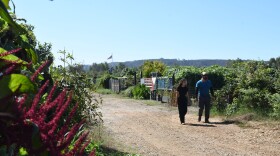It’s hard to find military or national security experts who are not supporters, if not all-out cheerleaders, for the use of high-tech surveillance systems to protect the nation’s borders.
The Department of Homeland Security just launched its tenth Predator B Unmanned Aerial System, commonly known as a drone, and now both northern and southern borders are covered.
Even though they cost $18 million apiece, many experts say they’re worth every penny.
"Homeland Security’s behind the times. It should have been doing this a decade ago," said Dan Gouré, a former high-ranking Defense Department official and current vice president of The Lexington Institute, a military think tank in Virginia.
"We’ve done as much as we can do on the surface and so you have to go into the air. And we’re going to have to increasingly have to go into the air in order to be effective," Gouré said.
Doug Davis has been working with drones for over two decades. He’s currently second in charge of the country’s largest drone development and testing center, at New Mexico State University. And he started the drone office at the Federal Aviation Administration.
"I don’t think there’s a whole lot of need to do this over Kansas, but for border surveillance, I believe we absolutely need that as a nation right now," Davis said. "What you have to balance is the safety of the airspace users and the people on the ground with the national security of the country."
Striking that balance is a thorny matter. Opponents of the drone program say the government can now spy into anyone’s backyard without their consent. That’s a scary thought, said Jay Stanley, who specializes in privacy issues at the American Civil Liberties Union.
"The government does have the right to protect its borders, but we haven’t sat down and gotten our policies straight about how we want to allow these technologies to be used, what kind of limits need to be placed on them in order to protect our privacy," Stanley said.
And then there’s also the question of the effectiveness of border drones. The Homeland Security Department's Office of Inspector General issued a scathing report in May on this issue. It questioned why drones are being put to use for fewer than 4,000 flight hours per year when they could be up in the air for more than 13,000 hours.
They’re just not being used efficiently, said Tom Barry, who researches drone issues at the Center for International Policy, a foreign policy think tank in Washington, D.C.
"They’re not in the air that much. They’re looking now for other missions, they send these drones to air shows in Paris or Wisconsin or Minnesota because they’re not a critical part of the border mission," Barry said.
But drone supporters countered that it’s a fairly new program and it’s going through some growing pains. As to privacy concerns, former Defense Department official Dan Gouré said: Get with the times.
"That horse left the barn years ago. We’re under constant surveillance. What’s the difference if it’s a camera on a pole or a camera on a drone? The answer is nothing, no difference," he said.
The public seems a bit conflicted on the issue, as well.
A majority of those surveyed in a recent poll backed the use of drones on the border.
"When it comes to using drones to control immigration on the nation’s borders, about two-thirds of the public agree with that," said Thomas Lamatsch, assistant director at the Polling Institute at Monmouth University in New Jersey.
But 42 percent of those in the same survey also expressed being “very concerned” about the impact of drones on their privacy.
"It's a mixed bag," Lamatsch said.









